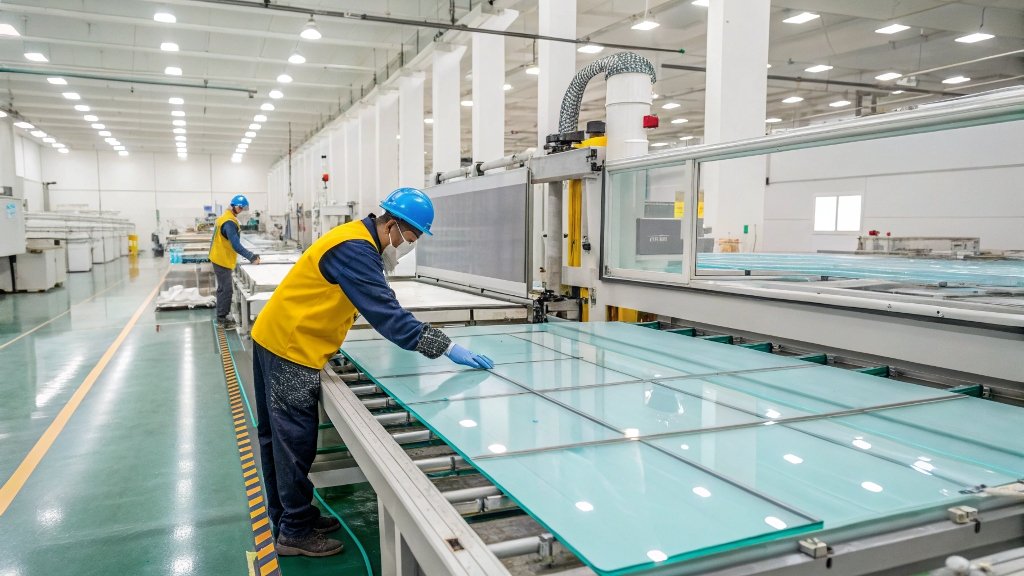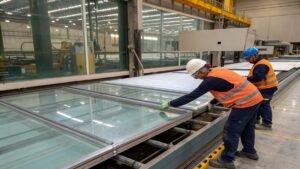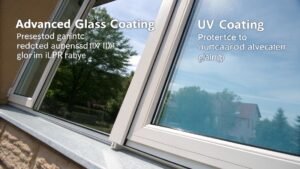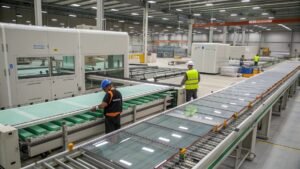Glass coating processes seem complex and technical. Many manufacturers wonder which method suits their production needs. Choosing the wrong coating technique can waste resources and compromise product quality.
Glass coating involves three primary methods: Physical Vapor Deposition (PVD), Chemical Vapor Deposition (CVD), and sol-gel processes. Each technique offers specific advantages for different applications and production scales.

I’ve worked with manufacturers across different industries for over a decade. The coating method you choose determines your product quality, production speed, and long-term success. Let me share what I’ve learned about each approach.
What Are the Main Glass Coating Application Methods?
Glass coating technology has evolved significantly over the past few years. Manufacturers now have multiple options for applying protective and functional coatings. Each method serves different production requirements and quality standards.
The three primary glass coating methods are PVD (Physical Vapor Deposition), CVD (Chemical Vapor Deposition), and sol-gel processes. Selection depends on coating thickness, durability requirements, and production volume.

Physical Vapor Deposition1 creates coatings through physical processes in vacuum environments. This includes magnetron sputtering and vacuum evaporation techniques. These methods produce extremely uniform, dense coatings with excellent adhesion properties. The process works by physically removing material from a target and depositing it onto the glass surface.
Chemical Vapor Deposition2 uses chemical reactions to form coatings directly on glass surfaces. Gas-phase precursors react at elevated temperatures to create solid films. This method provides excellent conformality and can coat complex geometries effectively. The chemical bonding creates strong adhesion between coating and substrate.
Sol-gel processes start with liquid precursors that transform into solid coatings through chemical reactions. This wet chemistry approach offers flexibility in composition and can be performed at relatively low temperatures. The method allows precise control over coating properties through solution chemistry.
Our photovoltaic glass ARC line demonstrates how different coating methods integrate into production workflows. The choice of application method affects both processing time and final product performance. Understanding these differences helps manufacturers make informed equipment decisions.
How Does Physical Vapor Deposition Work for Glass Coating?
Physical Vapor Deposition represents the most precise coating method available today. The process occurs in controlled vacuum environments where target materials vaporize and condense on glass surfaces. This creates extremely uniform, dense coatings with nanometer-level thickness control.
PVD creates coatings by physically transferring material from targets to glass substrates in vacuum chambers. The process achieves thickness precision within nanometers and produces highly durable, scratch-resistant films.

Magnetron sputtering3 uses magnetic fields to confine electrons and bombard target materials like SiO₂, TiO₂, or MgF₂. The bombardment ejects atoms and molecules that travel through the vacuum chamber and deposit onto glass surfaces. This method produces extremely dense films with strong adhesion properties. The magnetic confinement increases deposition rates while maintaining uniform coverage across large glass panels.
The process parameters critically affect coating quality. Chamber pressure, target power, substrate temperature, and gas flow rates must be precisely controlled. Higher temperatures generally improve film density and adhesion. Reactive sputtering introduces oxygen or nitrogen to form compound coatings like titanium dioxide or silicon nitride.
Vacuum evaporation offers a simpler alternative for certain applications. The process heats coating materials until they vaporize in high vacuum conditions. The vapor condenses on cooler glass surfaces to form thin films. This method works well for materials like magnesium fluoride that evaporate cleanly. However, it provides less control over film composition compared to sputtering.
PVD4 excels for high-performance applications requiring exceptional durability. The coatings resist scratching, chemical attack, and environmental degradation. Our experience shows PVD4 coatings lasting 10-15 years in harsh outdoor conditions. The method suits premium architectural glass, optical components, and electronic displays where performance justifies higher processing costs.
Why Choose Chemical Vapor Deposition for Industrial Applications?
Chemical Vapor Deposition offers unique advantages for large-scale industrial production. The process creates coatings through gas-phase chemical reactions at elevated temperatures. This approach provides excellent coating uniformity and strong chemical bonding with glass substrates.
CVD processes use gas-phase precursors that react on heated glass surfaces to form solid coatings. The method excels for high-volume production and creates films with superior adhesion and thermal stability.

Atmospheric pressure CVD5 operates at normal atmospheric conditions, making equipment design simpler and more cost-effective. The process introduces precursor gases like silane (SiH₄) and titanium tetrachloride (TiCl₄) along with oxygen into reaction chambers. At temperatures around 400-600°C, these gases react on glass surfaces to form oxide films like SiO₂ and TiO₂. The high temperature processing creates dense, well-adhered coatings.
Low-pressure CVD6 operates in reduced pressure environments, typically 1-100 Torr. The lower pressure improves gas transport and reaction uniformity. This variant provides better thickness control across large substrates but requires more complex vacuum equipment. The reduced pressure also allows lower processing temperatures for heat-sensitive substrates.
The chemical bonding in CVD creates exceptional adhesion strength. Unlike physical deposition methods, CVD forms chemical bonds between coating and substrate during the reaction process. This eliminates delamination issues and creates coatings that withstand thermal cycling and mechanical stress.
Our glass IR UV shading coating line incorporates CVD principles for architectural applications. The process deposits transparent films that block infrared and ultraviolet radiation while maintaining visible light transmission. This combination of properties requires precise chemical composition control that CVD provides effectively.
Processing temperatures affect coating properties significantly. Higher temperatures create denser, harder films with better optical properties. However, glass thermal stress increases with temperature, requiring careful process optimization. Modern CVD systems use rapid thermal processing to minimize glass heating while achieving desired coating properties.
When Should You Consider Sol-Gel Coating Processes?
Sol-gel processes offer flexibility and cost advantages for many glass coating applications. The method starts with liquid precursors that transform into solid coatings through controlled chemical reactions. This wet chemistry approach works at relatively low temperatures and accommodates various coating compositions.
Sol-gel coating creates films through liquid-phase chemistry followed by thermal curing. The process offers composition flexibility, low equipment costs, and ambient temperature processing capabilities.

Sol preparation begins with metal alkoxides like tetraethyl orthosilicate (TEOS)7 dissolved in solvents such as ethanol. Adding water and catalysts triggers hydrolysis and condensation reactions that form colloidal particles suspended in solution. The sol chemistry allows precise control over particle size, composition, and final coating properties. Different metal alkoxides create various oxide compositions including pure silica, titania, or mixed oxide systems.
Coating application uses standard industrial methods including dip coating, spray coating, or spin coating. Dip coating provides excellent uniformity for complex shapes by controlling withdrawal speed and solution viscosity. Spray coating suits large flat surfaces and high-volume production. The wet application process accommodates room temperature processing and doesn’t require expensive vacuum equipment.
Curing transforms liquid films into solid coatings through controlled heating. Low-temperature curing around 100-200°C removes solvents and promotes initial condensation. Higher temperature processing at 400-600°C creates denser, more durable films through complete condensation. The curing profile affects final coating properties including hardness, optical clarity, and environmental resistance.
Our perovskite material coating and annealing line demonstrates advanced sol-gel applications. The system deposits perovskite solutions onto glass substrates for next-generation solar cells. The process requires precise temperature control during curing to achieve optimal crystal structure and electronic properties.
Composition flexibility represents sol-gel’s greatest advantage. The method easily incorporates dopants, nanoparticles, and organic components impossible with vapor-phase processes. This enables functional coatings with properties like photocatalytic activity, antimicrobial effects, or specific optical characteristics. Our printing painting coating line for decoration glass combines sol-gel base coatings with decorative elements for architectural applications.
Conclusion
Glass coating methods each serve specific manufacturing needs. Choose PVD for premium durability, CVD for industrial scale, or sol-gel for flexibility and cost-effectiveness.
-
Explore this link to understand the principles and applications of Physical Vapor Deposition in various industries. ↩
-
Discover the advantages of Chemical Vapor Deposition and how it enhances coating technologies for better performance. ↩
-
Explore this link to understand the principles and advantages of Magnetron sputtering in film deposition. ↩
-
Discover why PVD coatings are essential for durability and performance in demanding environments. ↩ ↩
-
Explore this link to understand how Atmospheric pressure CVD simplifies equipment design and enhances cost-effectiveness. ↩
-
Discover the advantages of Low-pressure CVD, including improved gas transport and uniformity for better coating quality. ↩
-
Explore this link to understand the role of TEOS in sol-gel chemistry and its applications in various industries. ↩





